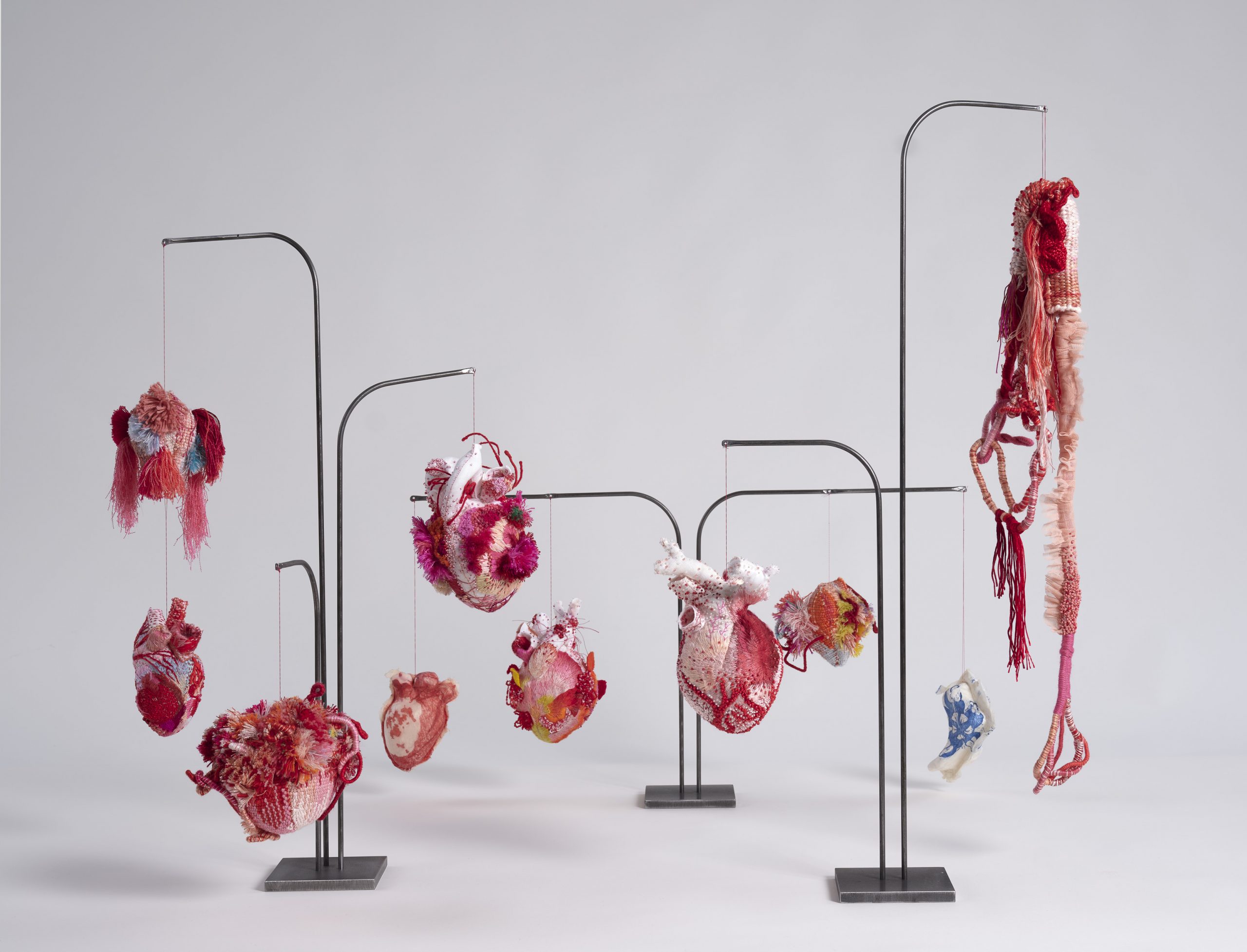Every year, Hand & Lock organizes a competition for the prestigious Prize for Embroidery to promote the use of hand embroidery and to discover emerging embroidery talent. This year, sponsors added Textile Art categories to the traditional Fashion categories. The 2016 brief challenges participants to create quality design that consumers will cherish for years and that will stand the test of time.
On Thursday, November 3rd, London’s Bishopsgate Institute hosted the final of the 2016 Hand & Lock Prize for Embroidery.
Today we’ll meet the first-place winner in the Fashion Open Category.
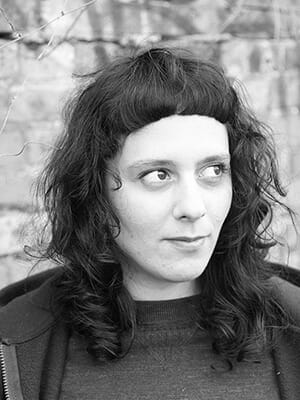
Name: Annalisa Middleton
Location: London, England
Website: annalisamiddleton.com
The Competition
Describe your Hand & Lock entry:
A couture version of the iconic shell suit with high relief goldwork embroidery contouring the body in the form of a shimmering space Octopus. Set on black, against a colourful backdrop of spider stitch galaxies and swirling stars, finished with honeycomb smocking on the wrist and ankle cuffs.
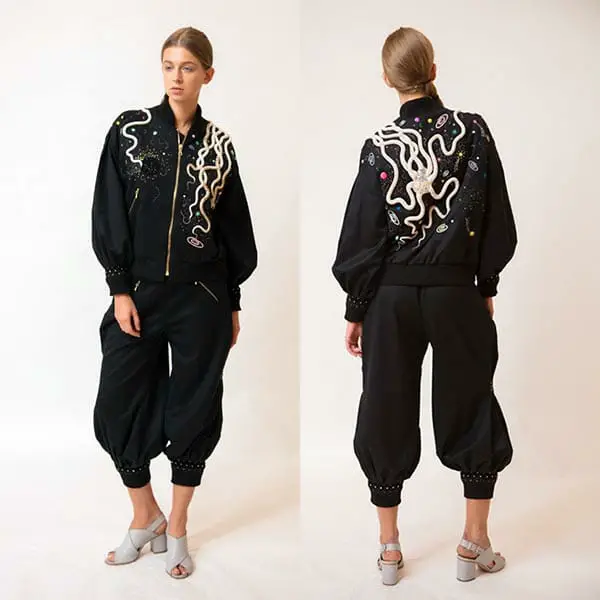
What made you want to enter this competition?
I entered this competition because I really wanted a challenge that would push my embroidery skills a bit further and give me an opportunity to engage with other embroiderers in a more professional context. I also found the brief to be quite malleable and knew even if I wasn’t shortlisted I’d end up with a beautiful piece that fitted nicely into my body of work.
What motivated your choice for your entry?
I chose to inform my design using influences from the contemporary artist Yayoi Kusama and Japanese Ukiyo-e which are traditionally woodblock prints of artists impressions, used as a form of social commentary between the 17th – 19th century. These graphic works are highly stylised, depicting anything from landscapes to bizarre erotica, often including themes derived of Shintoism, superstition and folklore. In comparison the work of Kusama is at times quite psychedelic, organic and suggestive of the infinite.
I thought these two themes complemented each other well, in that I could design something modern with an expressive motif in bold colours and also tell a story with a graphic monster from another world.
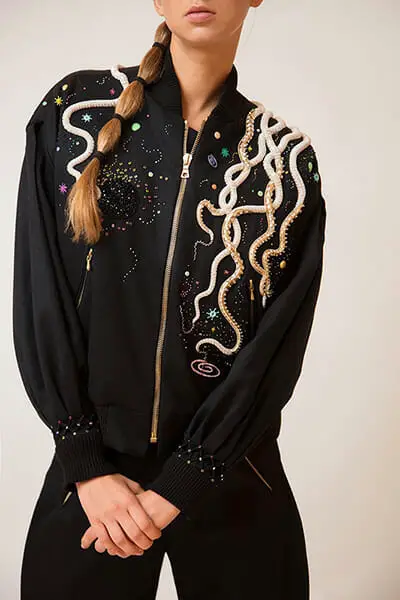
Who was your mentor, and how did s/he help with your project?
My mentor was Alice Richardson, a designer specialising in experimental couture hand embroidery.
I had a few chats with Alice, she gave some good advice, though by the time I spoke to her I was fairly committed to the process I had started, having the most difficult back panel entirely finished. She helped me understand different ways of approaching the design I wanted to achieve and where to concentrate my efforts. Having talked to her earlier I might not have built the piece as I did. She suggested doing the goldwork separately and stitching it on to the garment so it would sit exactly as I wanted it. In the end I was glad I embroidered straight on to the pieces, the overall effect looked almost seamless. Luckily I had the foresight to choose the most forgiving fabric I could find, a lightweight pure suiting wool with a bit of a sheen so it still looked nice. Had I used a silk satin with my method of construction, the results may not have been so good.
Are there any secrets you can now reveal about your entry?
I don’t really have any secrets about the piece though I can tell you I had some phases of pure hate going on throughout the construction. If there hadn’t have been the competition deadline, I may have actually lost hope and thrown it out the window. I suppose it’s often like that when you’re making an experimental piece that takes forever. You get impatient to see the end result and worry you’ve just wasted hundreds of hours of your life. After all it was only the second embroidered piece I’d ever made, I’m genuinely surprised, I can not only look at the thing without wincing, but with a sense of relieved satisfaction.
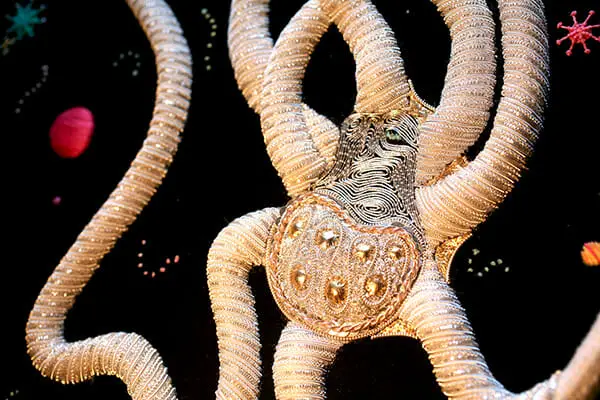
Past
When did you first take an interest in embroidery, and what inspired you to try it yourself?
I’m sure a lot of people say this but I first really took notice of the work of Michelle Carragher in Game of Thrones when I saw some close up pictures. This was the first time I’d looked closely at gold work out of the context of military dress. I’d describe these works as regal, yet organic, beautifully sewn couture garments, themed in medieval fantasy. I was fascinated by the range of materials and textures in her work and how expressive she was able to make the imagery by building up all the layers. I remember making a mental note at the time, ‘I must figure out how all this works’.
How did you first learn embroidery, and what was your first project?
I’d been thinking about embroidering one of my drawings, (also of an Octopus) on the back of a jacket and how to do it. I wasn’t really sure how it would work but decided it was something I’d like to learn. I then went for an open day at the Royal School of Needlework in Hampton Court and instantly regretted having already done a BA. I desperately wanted to study there but in reality I couldn’t afford to do even their day courses. So I then bought their Essential Stitch Guide in Goldwork by Helen McCook. It was everything I’d wish from an instruction manual, great photos rather than descriptions, taking you through the whole process from design to finish. After reading this it was easy to turn my drawing into a stitch plan and practice the techniques with great success.
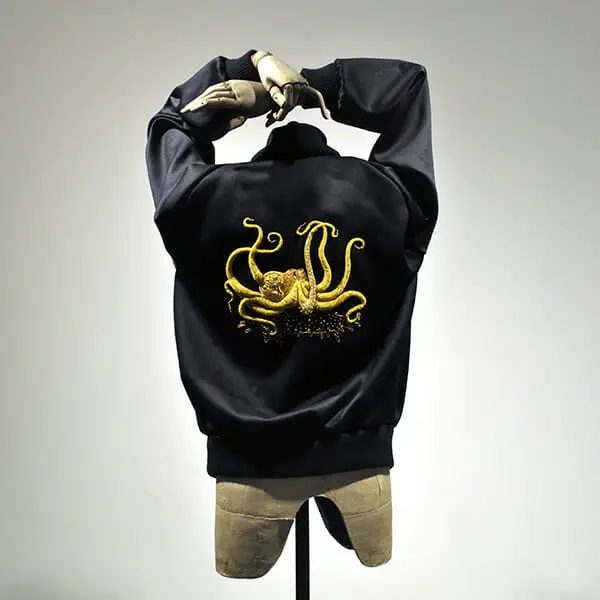
Tell us about your education background and how it led you to where you are.
I studied for my BA in Art and Performance at a really small university of 500 students in the picturesque Devon countryside. Dartington college of Arts was recognised internationally for its unique approach to teaching, encouragement of alternative thinking and a legacy of radical arts practitioners.
My work involved a lot of making and experimentation with emphasis on interdisciplinary practice. I made props, costumes, models, short films and stop motion animation, whilst beginning to relate myself to live performance which I often struggled with.
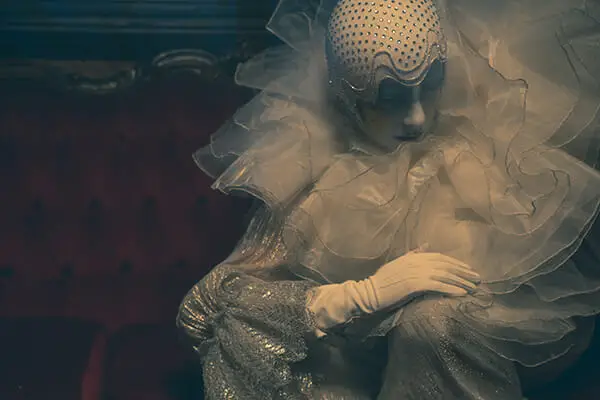
Even though I sometimes feel it would have been better to have waited until I was a bit older to decide on a degree, I feel very privileged to have had the Dartington experience. I’m deeply saddened that the college had to close in 2010, it’s a great shame education has become just another corporate business. These public institutions are so important to the future of our cultural identity, I only hope we can correct these mistakes so people still have access to the wonderfully diverse education that I did.
After graduating, I worked for six years making costumes for a small hire company in south London called Prangsta. I walked in to a treasure trove of exquisite garments, a world of eccentric characters, raw creativity, late nights and pure chaos. There I gained experience not only as a maker but as a stylist, set dresser and teacher, whilst also managing commissions and a range of creative projects relating to events.
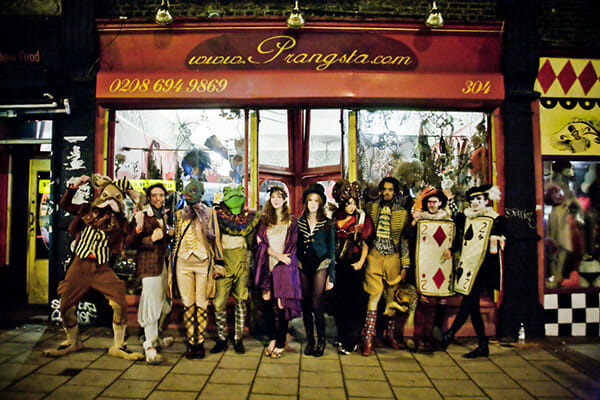
I loved my time at Prangsta, being able to exercise my own artistic license pretty much from the beginning, however I eventually missed having time for my own practice and grew tired of working in that aesthetic. So in 2015 I worked my last Halloween and left to find my own studio, becoming part of textile hub London and started working as an independent artist.
These two institutions have definitely shaped my process, though I’ve moved a little away from costume, my work often has symbolism or elements folklore/mythology informing the design. I still tend to think about the things I make not just as clothing or accessories but as objects worn by characters that are part of an imagined world. I’ve also begun to embrace and really see the relevance of live performance when exhibiting the garments I make. Where I used to struggle I’ve realised the problem, I’m not the performer, I’m not the subject, I need a muse. The process doesn’t quite feel finished until used in this wider context. I’m determined that crafts like textiles have more to offer the art world, we just need to think a little harder about how we represent/use them.


Present
What’s been the biggest surprise of your career and/or the projects you’ve undertaken?
I think winning Hand and Lock was a pretty big surprise, though I see my whole career as a string of small surprises. I’ve learnt it’s better for me not get too preoccupied with direction and success, I tend to just follow my intuition and see what lands in front of me when I’m not paying attention. I think it’s made my life a lot more interesting than the one I could imagine for myself.
What projects are on the horizon for you?
I’m planning to do the first proper photo shoot I’ve done in a while with my Hand and Lock entry and some other new bits. Very excited to be working with both the photographer and the model/muse, there’s going to be ink, I can’t tell you more than that.
As for stuff I’m making, I’ve decided I want to create my own brand, starting small with embroidered patches, that kind of stuff and hopefully moving on to some hand embroidered fashion pieces, maybe involving some digital print but for now I’m just focusing on the patches and small embroidered works, getting them refined and perfect then packaged beautifully.
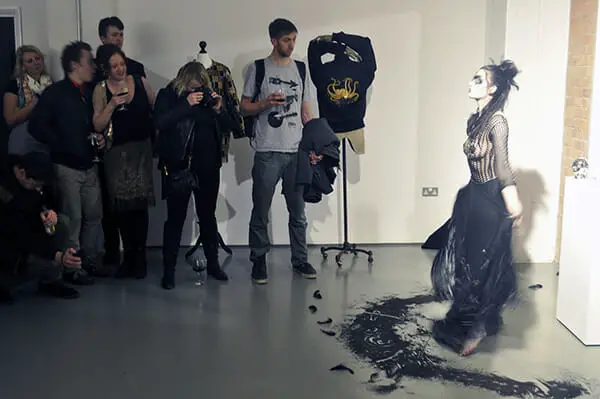
Where else can we see your work?
I’ll be exhibiting in London at our open studios this summer as part of Textiles Hub, on the 24th – 25th June, Kingsgate Workshops for more info.
Also you can follow me on Instagram @annalisaluciana
Future
What would you like to be doing five years from now?
As I said I don’t really like to plan too far ahead but I’d definitely like to have done a few more shows following on from my first solo exhibition (Symbolic fabrication) last year. I really enjoyed curating all my work also it felt so relevant to put it all into context and a necessary process to stop me getting lost. I’d like my future shows to be focussed on some larger textile artworks which use embroidery heavily in the process, using them as a backdrop for some diffusion costume and fashion pieces.
It would also be great to be able to travel and work, I’ve lived in and around London on a canal boat for the past few years and would love to travel the inland waterways and have a condensed studio on the boat. Embroidery definitely lends itself to small spaces which is handy.
Describe your dream commission. What and for whom is it?
I would love to work with Karin Dreijer Andersson of The Knife in context with her solo work as Fever Ray. I loved her first album, a melodic and hauntingly beautiful crossover between ambient electronica and Scandinavian pop music. If rumours are true she’s bringing out a second album this year. I’m not sure exactly sure what kind of costume I’d make her, it would start with a consultation but I imagine it would combine elements of folklore and futurism.
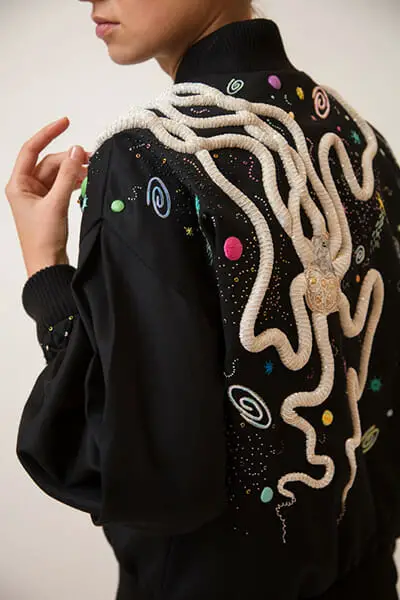
Rapid-fire Round: (Don’t think too hard about these.)
You can work with just one color for the next three years. What color do you choose? If it counts as a colour Black would be the obvious choice, if not Red.
What stitchable motif would you choose to represent you and your life? I’m quite into making sigils which are symbols created with a certain meaning or power in mind. I’d have to have a long think about it and draw one suitable to answer that question.
A book you’ve recently enjoyed: Alan Moore’s Jerusalem.
You must include something edible in your next design. What do you use, and how do you incorporate it? Sugar is often used to stiffen delicate items such as lace. I’ve wanted to experiment making some sculptural embroidery to look like coral, maybe for a mask or shoulder piece.
If you were not an artist, what would you be? A Skipper and sail all over the world.
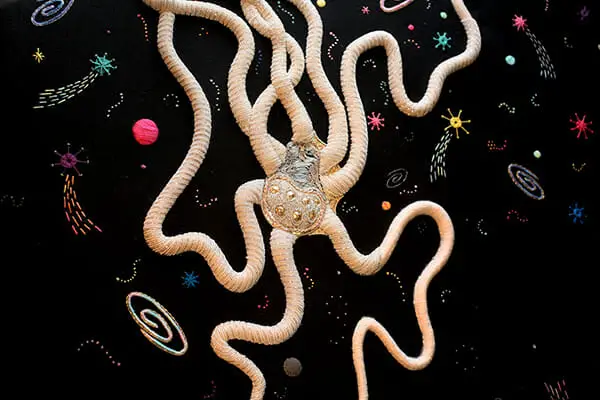
Favorite clothes to wear: Ones that are both flattering and comfortable.
You’re making a garment for an animal. What is the animal and what is the garment? It’s a tutu for a Staffordshire bull terrier named Tallulah.
A place you’d like to visit: Gaudi’s house
We’re hosting a show of “performance embroidery.” Describe your piece in the event. A rich Tapestry from floor to ceiling, reminisce of the Tibetan Thangka, guarded by two contortionists in shimmering scale-covered body suits with golden claws, to look somewhere between dragons and temple dogs.
Would you rather embroider with spaghetti or barbed wire? Spaghetti, my hands have enough holes as it is. Plus I think you could couch it quite effectively.



